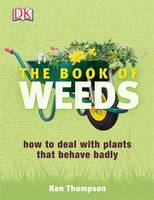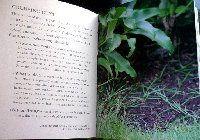Categories
Calendars
Guides
Reviews
Archive
Gallery
Articles
Ask Our Gardening Expert
Click
here for the index page to all the
gardening books we have reviewed. These are all honest, independent reviews. We
have read each book from cover to cover. Some of them them get the thumbs up,
but some definitely don't!
The Book of Weeds by Ken Thompson
At �12.99 you would expect to get a good book whose subject was limited to weeds.
If you pick up the Book of Weeds by Ken Thompson at a book shop the initial
impression is that this IS a good book for treating and identifying weeds. Lots of
pictures, lots of background information and a separate section on identifying
specific weeds.
Any good book of weeds should first enable you to clearly and easily identify
different weeds. The Book of Weeds doesn't do that on a couple of counts. First, if
the weed you are trying to identify is in the book then it's not particularly easy
to find. This is because the weeds appear to organised into random order. If I have
find a tall weed in my garden, with minimal flowers but attractive small leaves, I
don't want to look through the whole book to identify that particular weed. The weed
pages should be organised in some fashion that enables me to cut down on the number
of pages I need to view before finding it.
For example, small creeping weeds could be grouped together, so could
weeds with striking flowers, as could tall weeds. That, at least, would reduce the time
it took to identify a particular weed.
Or is it? The description indicates that Creeping Bent grows to a height
of 18in and the grass in the picture is definitely not 18in high. Take a look on Google
images and type in Agrostis stolonifera and you will quickly come to the
conclusion that Creeping bent has distinguishable seeds held high above the ground. But
the Book of Weeds has no such picture of the fully (or partially) grown Creeping Bent.
We found several examples of this lack of relevant pictures. The
Book of Weeds is therefore not recommended as a method of identifying weeds.
With regard to the rest of the Book of Weeds, it's well written if sometimes meandering
into areas which are a bit esoteric as far as weeds are concerned. You have to cover a
lot of pages to find the information you are after. Published By: Dorling Kindersley BUYING THIS BOOK COMMENTS END OF
REVIEW
But this book is not quite as good as it first appears. Read on to find out why we
have come to this opinion.

 Another problem is the relevance of the photography in many places. As an
example, the picture on the left (click to enlarge it and see more clearly) is
intended to be of of Creeping Bent (Agrostis stolonifera). For the complete
beginner it's not clear if the large leafy plant is Creeping Bent or if it's the
grassy plant lower down. Read the description and it becomes clear that Creeping
Bent is the lower grassy plant.
Another problem is the relevance of the photography in many places. As an
example, the picture on the left (click to enlarge it and see more clearly) is
intended to be of of Creeping Bent (Agrostis stolonifera). For the complete
beginner it's not clear if the large leafy plant is Creeping Bent or if it's the
grassy plant lower down. Read the description and it becomes clear that Creeping
Bent is the lower grassy plant.
First Published: 2009
Author: Ken Thompson
Title: The Book of Weeds
ISBN: 978 1 4053 3554 6
Price: �12.99
Pages: 192
Currently this book is available both online and on the High Street at most major
book shops.
If you have any comments about this independent book review of The Book of Weeds or wish to have a gardening book reviewed, then send an email to us by clicking the link below: